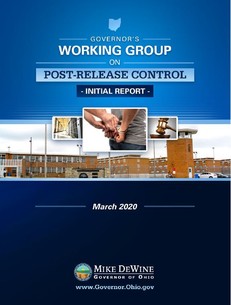FOR IMMEDIATE RELEASE:
March 9, 2020 |
MEDIA CONTACTS:
Dan Tierney: 614-644-0957
Jill Del Greco: 614-644-0957
|
Governor DeWine Announces Changes to
Post-Release Control Supervision in Ohio
(COLUMBUS, Ohio) ? Ohio Governor Mike DeWine announced today that he has directed the Ohio Department of Rehabilitation and Correction (ODRC) to implement a series of changes related to its post-release control supervision of former prison inmates. This work will include the development of new crime-scene correlation technology linked to a centralized database of offenders on electronic GPS monitoring.
?When offenders are released from prison under the supervision of the state, our number one obligation must be to ensure that this supervision is performed with a focus on keeping the public safe,? said Governor DeWine. ?Ohio?s post-release control population is growing, and many former inmates are high-risk to reoffend. The safety and security of the public demands that Ohio invest in the adequate supervision of dangerous offenders.?
ODRC will work toward developing the crime-scene correlation system in consultation with InnovateOhio, which focuses on improving government services through technology. The system, as planned, would allow law enforcement to compare crime scene addresses to the GPS data of offenders on post-release control. The tool would help investigators quickly determine if an individual on electronic monitoring was at the scene when the crime occurred and if so, potentially make an arrest before another crime happens.

The development of the crime-scene correlation system is one of 11 recommendations made by the Governor?s Working Group on Post-Release Control. Governor DeWine called on the working group to conduct a sweeping review of the policies and practices of ODRC?s Adult Parole Authority (APA) last year after a man on post-release control supervision was arrested for killing two children in Dayton.
Post-release control is a period of monitoring required for certain former inmates released from prison after serving the entirety of their sentences.
Other changes to Ohio?s post-release control supervision system include, but are not limited to:
- The APA will begin working to reduce parole officers? caseloads to 50:1 for general caseloads and 40:1 for specialized caseloads to allow parole officers to provide more thorough supervision. The current average caseload size is 76:1.
- The use of specialized caseloads will be expanded to place specific offenders, such as sex offenders and those suffering from mental illness, with parole officers who are experienced in supervising these populations.
- The APA will develop a case-assignment process that balances the number of offenders supervised by each parole officer with each offender?s risk level and the duties associated with each level.
- The Ohio Department of Public Safety will partner with the APA to more effectively respond to GPS-monitoring violations at night and on the weekends.
- The APA will require inclusion and exclusion zones for all offenders on GPS monitoring to clearly define specific areas where these offenders, including those who are homeless, are permitted or prohibited from being located.
- Ohio?s highest-risk offenders will be subject to longer periods of monitoring, and these offenders will be supervised by the most experienced parole officers.
- A sentinel events review process will be developed to regularly and thoroughly examine incidents of recidivism among offenders on post-release control.
- The APA will revise its policies to put more focus on behavioral-change strategies that help offenders make positive choices.
Governor DeWine also announced today that he will work with members of the general assembly to amend a statutory requirement that mandates GPS monitoring for certain low-risk offenders and redirect those resources to high-risk offenders on post-release control.
A full list of recommendations issued today by the Governor's Working Group on Post-Release Control can be found here.?
The working group will continue to collaborate to develop recommendations on other areas of concern such as ?truth in sentencing,? the effectiveness of halfway houses in supporting reentry and reducing recidivism, and the use of phone-reporting.
|
|
